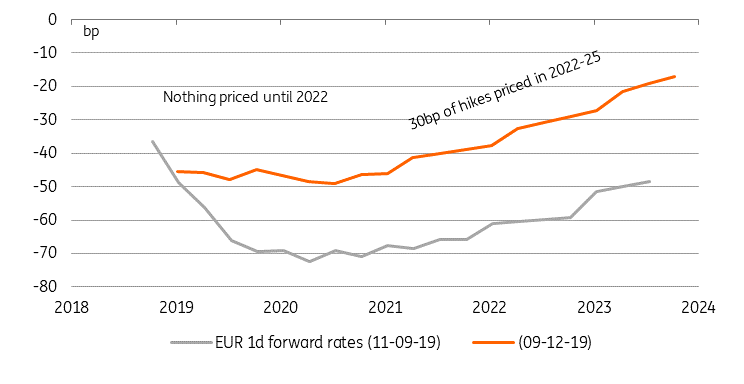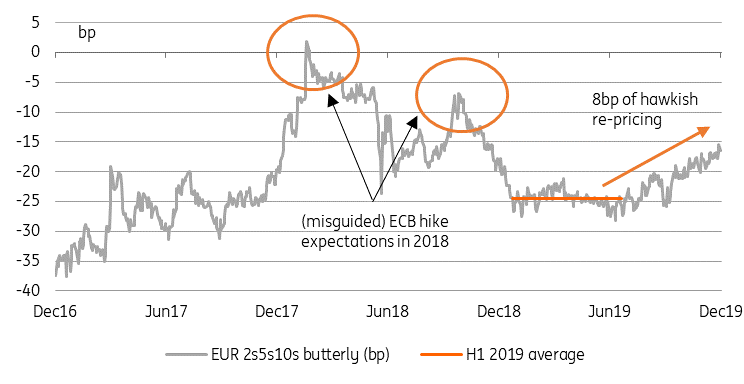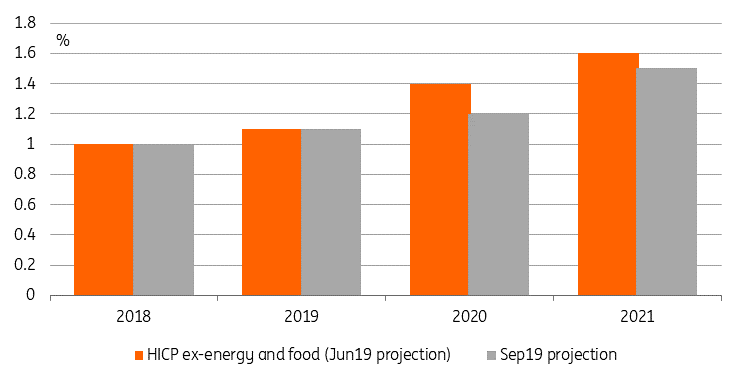Rates markets are pricing a much more hawkish path to ECB interest rates than three months ago. Some of it is related to improvement in sentiment, some to changes at the top of the ECB. Going forward, a communication vacuum at the central bank could leave markets to draw their own hakwish conclusion. High-beta fixed income assets valuation would be at risk.
Lagarde inherits more optimistic markets
The first press conference of a new ECB president is always an emotional moment for a rates strategist. It inevitably brings back memories of the previous president's first conference, and the realisation that these memories are now eight years old. Now is not the time to write a summary of all that has changed since Mario Draghi took office in November 2011, we direct our readers to the excellent piece written by our economics team on this subject. Instead, we will limit ourselves to how much has changed in rates markets since the September 2019 meeting, arguably Draghi's last ‘live' meeting, and what it says about how markets view the Draghi-Lagarde transition.
On a combination of encouraging domestic economic developments, global optimism, and shift in the ECB's communication, EUR money markets are pricing a much different path for ECB rates in the coming five years. In short, they foresee no more cuts in 2020-2021, and 30 basis points of tightening in 2022-24.
Lagarde re-pricing? EUR rates have changed their view on ECB rates
The same is visible in the cheapening of the belly of the curve. ‘Butterflies' such as EUR 2s5s10s (the difference between 5Y interest rates on the one hand, and 2Y and 10Y on the other) is now around 8bp higher than its average in the first half of this year, highlighting investors' expectation of policy tightening in the medium term. A comparison with the spikes in this butterfly in early and mid-2018 is telling. At that time, 2s5s10s rose above 0 compared to -16bp today. This suggests potential for further hawkish re-pricing if markets become excited about the chances of ECB tightening in the coming years. But will they?
Intermediate rates have risen since H1 2019
No definitive answer on the inflation outlook yet...
The ECB has tied the fate of both its main policy instruments - interest rates and asset purchases - to the inflation outlook. We defer to our economics team for an assessment of how likely inflation is to have reached its target by 2022, when the market is pricing a first hike. What we can say is that September ECB projections (to be updated this week) only have HICP ex-good and energy at 1.5% annualised in 2021. Whether this will be deemed sufficient to hike rates is uncertain. We feel more confident in saying that this will not be clear for the best part of 2020.
What then are rates markets getting excited about? For a start, the stabilisation in economic data since the September meeting could be a reason for markets questioning the outlook for inflation. This is possible, but with core HICP having averaged under 1.1% over the past 10 years, this seems unlikely. An alternative explanation is that the barrage of ECB comments stressing the negative side effects of negative rates, has made markets slowly start to re-assess the ECB's reaction function.
The ECB is forecasting only a modest uplift in core inflation
...but rates markets will draw their own conclusion
Enter Christine Lagarde. As our economics team has highlighted in their preview, one of Lagarde's first jobs is to mend fences after recent controversies from opposing hawks and doves, with Draghi in the role of chief dove. Whether this is justified or not, we see a risk that rates markets would consider a non-committal Lagarde as giving ground to the hawks who opposed Draghi so publicly. More practically for this week's press conference, we also see a risk that the absence of comment on the ECB's appropriate policy stance (beyond trotting out the official line), would be construed as an endorsement of hawkish market expectations.
The time between now and when an uplift (if any) in core inflation is confirmed could be considerable but rates markets will not wait to price a hawkish ECB view. We see a risk of this happening in the coming months as Lagarde et al. stay noncommittal ahead of the upcoming policy review and avoid controversial subjects that would reopen divisions among Governing Council members. As has been the case in the past, this would probably prove premature but financial markets are forward-looking in nature and reflect whatever information is available to them at the time. A lack of policy direction at the ECB could reinforce current hawkish market assumptions.
At a time when central bank policy acts as a prop for many assets' valuation, we see a risk of divergence between the perceived ECB stance and a still tepid outlook. We are particularly cautious on the outlook for high-beta fixed income markets as an increase in rates volatility would be detrimental to the risk-reward of owning these assets for their carry.
Read the original analysis: EUR Rates: how hawkish can they get?
Content disclaimer: This publication has been prepared by ING solely for information purposes irrespective of a particular user's means, financial situation or investment objectives. The information does not constitute investment recommendation, and nor is it investment, legal or tax advice or an offer or solicitation to purchase or sell any financial instrument. Read more here: https://think.ing.com/content-disclaimer/
Recommended Content
Editors’ Picks
AUD/USD: Next stop emerges at 0.6580

The downward bias around AUD/USD remained unabated for yet another day, motivating spot to flirt with the area of four-week lows well south of the key 0.6700 region.
EUR/USD looks cautious near 1.0900 ahead of key data

The humble advance in EUR/USD was enough to partially leave behind two consecutive sessions of marked losses, although a convincing surpass of the 1.0900 barrier was still elusive.
Gold extends slide below $2,400

Gold stays under persistent bearish pressure after breaking below the key $2,400 level and trades at its lowest level in over a week below $2,390. In the absence of fundamental drivers, technical developments seem to be causing XAU/USD to stretch lower.
Breaking: SEC gives final approval for Ethereum ETFs to begin trading tomorrow

The Securities and Exchange Commission approved the S-1 registration statements of spot Ethereum ETF issuers on Monday, according to the latest filings on its website. Following the approval, issuers have started making moves as the products are set to begin trading on exchanges tomorrow.
What now for the Democrats?

Like many, I applaud Biden’s decision. I would have preferred that he’d made it sooner, but there’s still plenty of time for the Democrats to run a successful campaign. In fact, I wish something on the order of a two-month campaign – as opposed to a two-year campaign – were the norm and not the exception.


